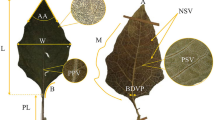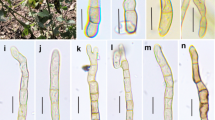Abstract
A preliminary account of Hypoxylon species (Xylariaceae) from the hitherto widely unexplored “Yungas” mountain forests of Northwest Argentina is presented. Two new species are described based on extensive morphological, molecular (ITS region of rDNA, partial β-tubulin gene) and chemotaxonomic data. Hypoxylon spegazzinianum is close to H. erythrostroma, but differs by larger ascospores and a virgariella-like asexual morph. Hypoxylon calileguense resembles H. subgilvum when growing on wood, but can be distinguished by larger ascospores and a fawn to brick stromatal surface colour. Stromata found on bark have affinities to H. pelliculosum, but differ in their stromatal surface colour and conspicuous amyloid apical apparatus. In addition, nine taxa of Hypoxylon are reported for Argentina for the first time, and some details on their asexual state and stromatal secondary metabolites are reported. An updated dichotomous key for Hypoxylon species from Argentina is provided.








Similar content being viewed by others
Notes
Actually, these authors have distinguished various subtypes of branching patterns according to the complexity of the conidiophores, which are here accepted in the species descriptions; see Stadler et al. (2014) for further explanation.
The characteristics of this species are reported concurrently in by Li et al (2016, in press).
References
Bills GF, Gonzalez-Menendez V, Martın J, Platas G, Fournier J, Persoh D, Stadler M (2012) Hypoxylon pulicicidum sp. nov. (Ascomycota, Xylariales), a pantropical insecticide-producing endophyte. PLoS ONE 7, e46687
Bitzer J, Köpcke B, Stadler M, Hellwig V, Ju YM, Seip S, Henkel T (2007) Accelerated dereplication of natural products, supported by reference libraries. Chimia 51:332–338
Bitzer J, Læssøe T, Fournier J, Kummer V, Decock C, Tichy HV, Piepenbring M, Persǒh D, Stadler M (2008) Affinities of Phylacia and the daldinoid Xylariaceae, inferred from chemotypes of cultures and ribosomal DNA sequences. Mycol Res 112:251–270
Bodo B, Tih RG, Davoust D, Jacquemin H (1983) Hypoxylone, a naphthyl naphthoquinone pigment from the fungus Hypoxylon sclerophaeum. Phytochemistry 22:2579–2581
Brown AD (1995) Las selvas de montaña del noroestede Argentina: problemas ambientales e importancia de su conservación. In: Brown AD, Grau HR (eds) Investigación, conservación y desarrollo en las selvas subtropicales de montaña. Laboratorio de Investigaciones Ecológicas de las Yungas, UNT, Tucumán, Argentina, pp 9–18
Brown AD, Grau A, Lomáscolo T, Gasparri NI (2002) Una estrategia de conservación para las selvas subtropicales de montaña (Yungas) de Argentina. Ecotropicos 15:147–159
Carmona A, Fournier J, Williams C, Piepenbring M (2009) New records of Xylariaceae from Panama. N Am Fungi 4:1–11
Cruz KS, Cortez VG (2015) Hypoxylon (Xylariaceae, Ascomycota) from Western Paraná, Brazil. Br J Bot 38:889–901
Fournier J, Köpke B, Stadler M (2010) New species of Hypoxylon from western Europe and Ethiopia. Mycotaxon 113:209–235
Fournier J, Pelissier M, Lechat C (2014) Hypoxylon flavocremeum sp. nov. (Xylariaceae), a new species from Mayotte (France Outre-Mer), with notes on some other Hypoxylon spp. collected in this island. Ascomycete.org 6:65–71
Fournier J, Lechat C, Courtecuisse R (2015) The genus Hypoxylon Xylariaceae) in Guadeloupe and Martinique (French West Indies). Ascomycete.org 7:145–212
Hellwig V, Ju YM, Rogers JD, Fournier J, Stadler M (2005) Hypomiltin, a novel azaphilone from Hypoxylon hypomiltum, and chemotypes in Hypoxylon sect. Hypoxylon as inferred from analytical HPLC profiling. Mycol Prog 4:39–54
Hladki AI, Romero AI (2006) Revision de las especies de Hypoxylon propuestos por Spegazzini. Lilloa 43:45–60
Hladki AI, Romero AI (2009a) Taxonomic and nomenclatural aspects of Hypoxylon taxa from Southern South America proposed by Spegazzini. Mycologia 101:733–744
Hladki AI, Romero AI (2009b) Novedades para los Géneros Annulohypoxylon e Hypoxylon (Ascomycota, Xylariaceae) en la República Argentina. Darwiniana 47:278–288
Hsieh HM, Ju YM, Rogers JD (2005) Molecular phylogeny of Hypoxylon and closely related genera. Mycologia 97:844–865
Ju YM, Rogers JD (1996) A revision of the genus Hypoxylon. Mycologia Memoir n° 20. APS Press, St. Paul, 365 pp
Kuhnert E, Fournier J, Peršoh D, Luangsa-ard JJD, Stadler M (2014a) New Hypoxylon species from Martinique and new evidence on the molecular phylogeny of Hypoxylon based on ITS rDNA and β-tubulin data. Fungal Divers 64:181–203
Kuhnert E, Heitkämper S, Fournier J, Surup F, Stadler M (2014b) Hypoxyvermelhotins A-C, new pigments from Hypoxylon lechatii sp. nov. Fungal Biol 118:242–252
Kuhnert E, Surup F, Sir EB, Lambert C, Hyde KD, Hladki AI, Romero AI, Stadler M (2015) Lenormandins A – G, new azaphilones from Hypoxylon lenormandii and Hypoxylon jaklitschii sp. nov., recognised by chemotaxonomic data. Fungal Divers 71:165–184
Li GJ et al (2016) Fungal diversity notes 253–370: taxonomic and phylogenetic contributions to fungal taxa. Fungal Divers (in press)
Petch T (1924) Xylariaceae Zeylanicae. Annals of the Royal Botanic Gardens (Peradeniya) 8:119–166
Quang DN, Stadler M, Fournier J, Asakawa Y (2006) Carneic acids A and B, two chemotaxonomically significant antimicrobial agents from the xylariaceous ascomycete, Hypoxylon carneum. J Nat Prod 69:1198–1202
Rayner RW (1970) A mycological colour chart. Commonwealth Mycological Institute, Kew and British Mycological Society
Senanayake IC, Maharachchikumbura SSN, Kevin D, Hyde KD, Bhat JD, Jones EBG, McKenzie EH, Dai DQ, Dagaranagama DA, Dayarathne MC, Goonasekara ID, Konta S, Li WL, Shang QJ, Stadler M, Wijayawardene NN, Xiao XP, Norphanphoun C, Li QR, Liu XZ, Bahkali AH, Kang JC, Wang Y, Wen TC, Wendt L, Xu JC, Camporesi E (2015) Towards unraveling relationships in Xylariomycetidae (Sordariomycetes). Fungal Divers 73:73–144
Sir EB, Parrado MF, Hladki AI, Romero AI (2012) Biodiversity of Xylariaceae (Ascomycota) and their hosts in protected areas from Tucumán (Argentina). Kurtziana 37:35–48
Sir EB, Kuhnert E, Surup F, Hyde KD, Stadler M (2015) Discovery of new mitorubrin derivatives from Hypoxylon fulvo-sulphureum sp. nov. (Ascomycota, Xylariales). Mycol Prog 14:28
Spegazzini C (1880) Fungi Argentini. Ann Soc Cient Argent 9:158–192
Spegazzini C (1891) Fungi Guaranitici novi vel critici. Rev Argent Hist Nac 1:398–432
Spegazzini C (1922) Fungi Paraguayensis. Ann Mus Nac B Aires 31:355–450
Stadler M, Fournier J (2006) Pigment chemistry, taxonomy and phylogeny of the Hypoxyloideae (Xylariaceae). Rev Iberoam Micol 23:160–170
Stadler M, Wollweber H, Mühlbauer A, Henkel T, Wollweber H, Asakawa Y, Hashimoto T, Rogers JD, Ju YM, Wetzstein HG, Tichy HV (2001) Secondary metabolite profiles, genetic fingerprints and taxonomy of Daldinia and allies. Mycotaxon 77:379–429
Stadler M, Læssøe T, Fournier J, Decock C, Schmieschek B, Tichy HV, Peršoh D (2014) A polyphasic taxonomy of Daldinia (Xylariaceae). Stud Mycol 77:1–143
Stamatakis A (2006) RAxML-VI-HPC: maximum likelihood-based phylogenetic analyses with thousands of taxa and mixed models. Bioinformatics 22: 2688–2690
Surup F, Kuhnert E, Lehmann E, Heitkämper S, Hyde KD, Fournier J, Stadler M (2014) Sporothriolide derivatives as chemotaxonomic markers for Hypoxylon monticulosum. Mycology 5:110–119
Triebel D, Peršoh D, Wollweber H, Stadler M (2005) Phylogenetic relationships among Daldinia, Entonaema and Hypoxylon as inferred from ITS nrDNA sequences. Nova Hedw 80:25–43
Acknowledgments
The DAAD and the Argentina Ministerio de Ciencia, Tecnología e Innovación Productiva are gratefully acknowledged for an academic exchange grant. We gratefully acknowledge support from the curators of various international herbaria, above all, BPI, LPS, S and WSP, who provided important specimens for the present study. We are deeply indebted to Markus Scholler (KR) for realizing international loan transactions on our behalf. We would also like to express their gratitude to the Administration of National Parks of Argentina, the Ministry of the Environment of Salta Province and Provincial Direction of Biodiversity of Jujuy Province for authorization of collection. Manfred Rohde is thanked for SEM recordings. Simone Heitkämper, Anke Skiba, Cäcilia Schwager and Philine Wotsch are thanked for their assistance with handling of the Argentine strains.
Author information
Authors and Affiliations
Corresponding author
Additional information
Section Editor: Gerhard Rambold
Rights and permissions
About this article
Cite this article
Sir, E.B., Kuhnert, E., Lambert, C. et al. New species and reports of Hypoxylon from Argentina recognized by a polyphasic approach. Mycol Progress 15, 42 (2016). https://doi.org/10.1007/s11557-016-1182-z
Received:
Revised:
Accepted:
Published:
DOI: https://doi.org/10.1007/s11557-016-1182-z




